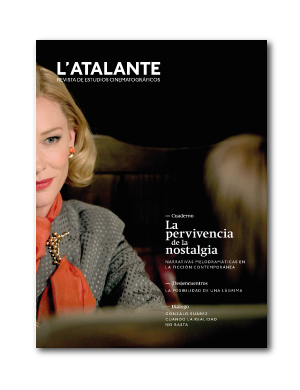Published 2018-01-31
Keywords
- Melodrama,
- Gesture,
- Performers,
- Bodies,
- Melodramatic and Oneiric Documentary
- Vanguard,
- Pathosformel,
- Emotions. ...More
How to Cite
Abstract
One of the most outstanding features of contemporary culture is the comeback of the emotional factor to the foreground. This implies an exacerbation of the emotions that can be comparable to melodrama. Beyond the tradition expressed in different media that eventually flowed into cinema, melodrama is now the device that permits us to discover the essential function that affections play in visual expressions, to which the body in motion is their essential vehicle. Melodrama has turned, then, into a symbolic form. In this sense, the contemporary documentary presents itself as the best lab to observe the postmodern prolongation of Aby Warburg’s pathosformel, a concept enunciated to study images of emotion throughout History. Based on the body, the melodramatic gesture expands its meaning up to encompass all the field of the image transformed in an emotional landscape.
Downloads
References
— (2008). <em>La potencia del pensamiento</em>. Barcelona: Anagrama.<br>
Burucúa, J. E. (2003). <em>Historia, arte, cultura. De Aby Warburg a Carlo Ginzburg</em>. Buenos Aires: Fondo de Cultura Económica. <br>
Benjamin, W. (1990). <em>El origen del drama barroco alemán</em>. Madrid: Taurus.<br>
Careri, G. (2010). <em>La fabbrica degli affetti. La Gerusalemme liberata, dai Carracci a Tiepolo</em>. Milan: Il Saggiattore (edición Kindle). <br>
Català, J. M. (2009). <em>Pasión y Conocimiento. El nuevo realismo melodramático</em>. Madrid: Cátedra.<br>
Daney, S. (1992). El travelling de Kapo. <em>Trafic</em>, 4. Recuperado de http://cinefagos.net/paradigm/index.php/otros-textos/documentos/442-el-travelling-de-kapo.<br>
Didi-Huberman, G. (2000). <em>Devant le temps</em>. París: Les Éditions de Minuit.<br>
— (2002). <em>L’image survivante. Histoire de l’art et temps des fantômes selon Aby Warburg</em>. París: Les Éditions de Minuit.<br>
Efal, A. (2000). Warburg’s Pathos Formula in Psychoanalytic and Benjaminian Contexts. <em>Assaph-Studies in Art History</em>, 5, 221-238.<br>
Gombrich, E. H. (1993). <em>La imagen y el ojo</em>. Madrid: Alianza forma. <br>
Hustvedt, S. (2017). <em>La dona que mira els homes que miren a les dones. Assajos sobre feminisme, art i ciencia</em>. Barcelona: Edicions 62. <br>
Jousse, M. (1978). <em>L’Anthropologie du Geste</em>. París: Gallimard.<br>
Kline, K. (1998). In or Out of the Picture. Claude Cahun and Cindy Sherman. En W. Chadwick (ed.), <em>Mirror Images: Women, Surrealism, and Self-representation </em>(pp. 66-81). Cambridge: the MIT Press.. <br>
Leys, R. (2011). The Turn to Affect: A Critique. <em>Critical Inquiry</em>, <em>37</em>(3), 434-472.<br>
McConache, B. A. (1992). <em>Melodramatic Formations: American Theatre and Society, 1820-1870. Studies in Theatre History and Culture</em>. Iowa City: University of Iowa Press.<br>
Michaud, P. A. (1998). <em>Aby Warburg et l’image en mouvement</em>. París: Éditions Macula. <br>
Naremore, J. (1988). <em>Acting in the Cinema</em>. Berkeley: University of California Press. <br>
Neu, J. (2000). <em>A Tear Is an Intellectual Thing. The Meanings of Emotion</em>. Nueva York: Oxford University Press.<br>
Nussbaum, M. C. (2008). <em>Paisajes del pensamiento. La inteligencia de las emociones</em>. Barcelona: Paidós.<br>
Rampley, M. (2000). <em>The Remembrance of Things Past. On Aby M. Warburg and Walter Benjamin</em>. Wiesbaden: Harrassowitz Verlag. <br>
Rivette, J. (1961). De la abyección. <em>Cahiers du cinéma</em>, 120. Recuperado de https://lenguajecinematografico.files.wordpress.com/2013/04/de-la-abyeccion-rivette.pdf.<br>
Ruvituso, F. L. (2014). La distancia que acerca. Hacia un espacio para pensar las imágenes. <em>Arte e Investigación</em>, 10, 74-80.<br>
Stiegler, B. (2016). <em>Dans la disruption. Comment ne pas devenir fou?</em> París: Éditions les liens qui libèrent.<br>
Warburg, A. (2010). <em>Atlas Mmemosyne</em>. Madrid: Akal.<br>
Zunzunegui, S. (2011). El travelling de Paisà. <em>Cahiers du Cinéma España</em>, 51, 63.</p>

